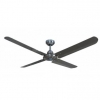
Interview with Glen Day from Ventair
We talk to Glen Day from Ventair about how to choose the right ceiling fan.
What makes Ventair fans better than other ceiling fans?
“We are innovators in our field, bringing new products and designs to the Australian market. Some examples of this can be seen with our which is a contemporary ceiling fan with a metal blade featuring a kick in the trailing edge to produce higher airflow. Our DC energy efficient ceiling fans with wall controllers are another example of our innovative product range. The DC comes with an eight speed wall controller. No one in the Australian market has that. All of the other DC ceiling fans in the Australian market require a remote control and in many applications people don’t want remote controls. This is often the case with rental properties, TAFE and universities. Another example of our unique product range is our IQFan designer series. In terms of style and design, there’s nothing really like them in Australia today. They also promote extreme airflow.”
If you have air conditioning, why would you still need a fan?
“One of the points that even air conditioning manufacturers will agree with is that you can significantly improve the efficiency of your air conditioner by incorporating ceiling fans. The reason for this is in particular reference to heating. Fans all have a switch on the motor which says summer/winter. It’s important to know that you’ve got your ceiling fan running in the right direction so that in summer your fans are running clockwise. In winter if you were to turn the switch to the winter setting the fan will move in reverse. With an air conditioner, the hot air rises and sits towards the ceiling. If you run your air conditioner with your ceiling fans on low in reverse (the winter setting), it actually forces the air up into the ceiling space and pushes the air back over and down through the room so it circulates your temperature and your hot air throughout your home, making the heating even and assisting your air conditioner to work more efficiently too.”
How are ceiling fans installed? Is it expensive?
“It depends on the type of fan. If you’re installing a ceiling fan which incorporates a remote control and you’re replacing an existing light fitting with a ceiling fan light remote kit there’s no real hard wiring required from the electrician, they’ll simply use the existing power circuit that’s there. There’s no real additional wiring required so that’s a cheaper installation. If you are putting a ceiling fan into a room where there is no current wiring then they’ll need to run some cables back down the walls to pick up the switches and controllers for the ceiling fan.”
Why would I want a ceiling fan that’s reversible in the way that it rotates?
“It’s mainly important for during the winter so that you can circulate the hot air off your ceiling space and push it down into your room, making your heating a lot more efficient. You could find that a foot or so off your ceiling it could be 3 or 4 degrees warmer than what it is throughout the rest of the room so if you circulate that air, the temperature is more even. This will mean your air conditioner will be more efficient and probably do less work as well, extending the life of your air conditioning unit.”
Are ceiling fans cost effective to run?
“Yes. They come in a range of motor sizes so they can range from anything from 55 watts depending on the type of fan to even 100 watts or over, in typical ceiling fan construction. If you look at our new DC energy efficient ceiling fans they run up to 80% more efficiently than a traditional ceiling fan because of the construction and design within a DC motor.”
Is there a difference in the performance of the 3, 4 and 5 blade ceiling fans?
“The performance of the ceiling fan is generally determined by the pitch of the blade. The pitch of the blade really determines how much air is going to be forced down. Imagine if you run a ceiling fan and it had a perfectly flat blade, you would virtually have no air running off it because it’s not sweeping any air down. It’s the pitch of that blade that creates the airflow.
Traditionally people think that 3 blade fans move more air than 4 blade fans and that could be right with the types of fans we see in our market because they tend to be 3 bladed metal fans which have a kink or a tilt in the trailing edge of the blade increasing the blade pitch which increases the airflow. Getting up into 4 blade and 5 blade ceiling fans it’s not so much to do with the blade it’s more to do with the pitch and the speed at which the motor is running at.
The more pitch you can get in that blade the more airflow you can get off that ceiling fan. That needs to be matched with the motor and a few other things because the more force that’s generated by the blade, the stronger the motor needs to be. For instance it’s not untypical to see blade pitches on ceiling fans from 11 degrees through to 30 degrees. So it’s important for the consumer to know what they’re buying because if they buy a ceiling fan with a blade pitch of 11 degrees then it’s not going to move anywhere near as much air as something with a 28-30 degree blade pitch on it. It’s one of the most important factors to know: what the pitch of the blade is so you can understand what airflow you’re going to get from that ceiling fan.”







